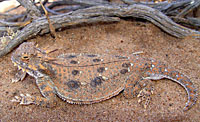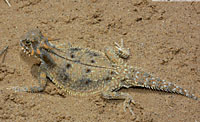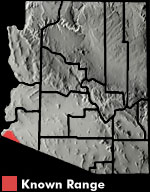Online Field Guide to The Reptiles and Amphibians of Arizona


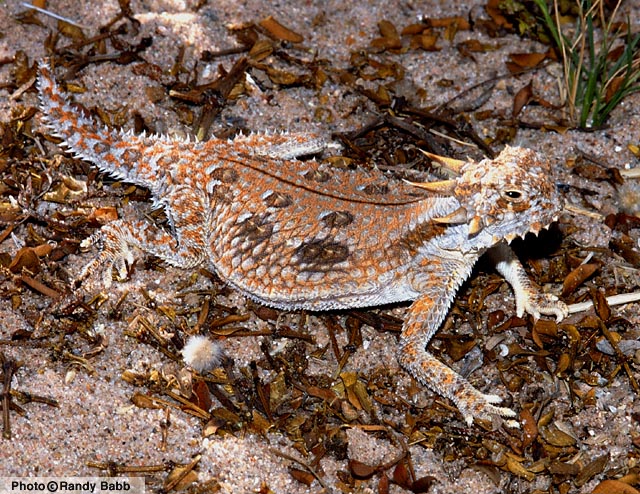
Yuma County, AZ
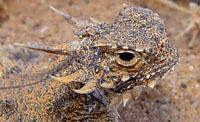 Yuma Co., AZ |
||
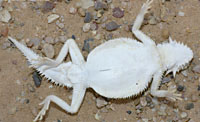 Yuma Co., AZ |
| FLAT-TAILED HORNED LIZARD Phrynosoma (Anota) mcallii |
|
|
DESCRIPTION: A small (up to 87 mm or 3.4″ from snout to vent), exceptionally flat and wide lizard with a long (for a horned lizard) broad, flat tail and a dark stripe running down the middle of the back. Six long, horn-like scales project from the back of the head. The two central horns are noticeably longer than the others. Smaller pointed scales protrude from the sides of the jaw. Several isolated, pointed, scales project from the back. Each lower side of the body is edged with two fringes of enlarged, pointed scales. There are no external ear openings. Base coloration is tan, orange-brown, or reddish brown and usually matches the sand on which the lizard lives. The back is marked with rows of dark gray-brown, soft-edged, circular blotches. The underside is plain and pale. Its dark dorsal stripe distinguishes this lizard from all other horned lizards in Arizona. DISTRIBUTION: This lizard is found in the extreme southwestern corner of the state at elevations ranging from sea level to about 850’. HABITAT: In Arizona the Flat-tailed Horned Lizard is found exclusively in the Lower Colorado River subdivision of the Sonoran Desertscrub community. It inhabits low dunes and flatlands with hard-packed sand substrate. BEHAVIOR: A diurnal, ground-dwelling lizard that spends the nighttime hours sleeping on the surface of the sand. It burrows under the sand to seek shelter from the mid-day heat. It is often encountered basking and foraging in the morning sun. When encountered it usually remains motionless relying on its cryptic coloration to avoid detection. When captured it may inflate itself by gulping air and poke with the horns. DIET: The Flat-tailed Horned Lizard feeds primarily on ants. It also occasionally eats beetles and other insects. Standing water is a rarity in this lizard’s range and as a result most of its water is acquired from its food. REPRODUCTION: Mating takes place in spring and clutches of eggs are laid in late spring and early summer. Clutch size ranges from 3 to 10 eggs. REMARKS: The small range of this lizard is threatened by agricultural and urban development and off road vehicles. By Thomas C. Brennan
Brennan, T. C., & A. T. Holycross. 2006. A Field Guide to Amphibians and Reptiles in Arizona. Arizona Game and Fish Department. Phoenix, AZ Stebbins, R.C. 2003. A Field Guide to Western Reptiles and Amphibians, Third Edition. Houghton Mifflin Company, Boston, MA. |
|
Visit Partners in Amphibian and Reptile Conservation:


HOME
Copyright © 2023, Arizona Game and Fish Department. All rights reserved.
If you make use of the textual contents of this site in reports, publications, etc. please cite and credit the author(s) and photographer(s). All photos on this website are copyrighted. However, those found in the species account section may be used for any noncommercial scientific, educational, or conservation purposes provided that photographs are not altered and continue to bear the copyright symbol and name of the photographer. Please contact the photographer regarding commercial use of copyrighted photographs.










